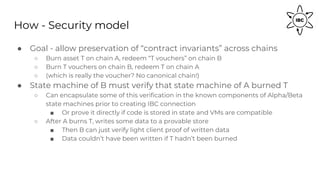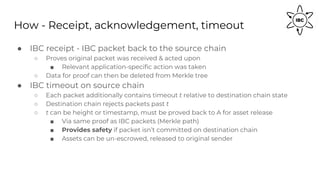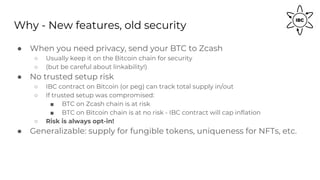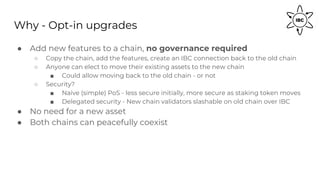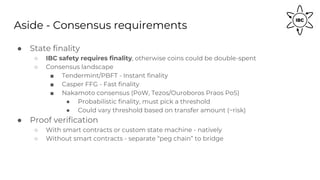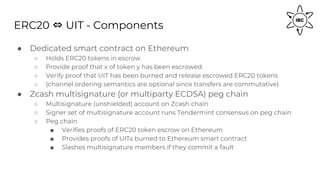Interblockchain Communication for Blockchain Interoperability
- 1. Christopher Goes, Cosmos IBC & public-private blockchain interoperation
- 2. About this talk ● Explain IBC design goals ● Demystify implementation ○ IBC is a protocol! ○ How to do it yourself (rapid version) ● Walk through example ○ Using IBC to connect Ethereum & Zcash ○ Shielded ERC20 transactions: privately send your existing ERC20 tokens
- 3. What - “Inter-blockchain communication” ● Mechanism for relaying data packets between chain A & chain B ● Off-chain relayers responsible for watching chain A & committing transactions to chain B ○ Relayers are not permissioned, anyone can relay ● Opaque payload: IBC protocol defines causal ordering semantics, any application logic can be implemented on top
- 4. What - Authenticated message passing ● Rules on chain B which define a subset of accepted packets ○ If packet has been received on B, know something about state of A ● Chain B verifies proof that packet has been sent on chain A ● Various methods of doing so, with different security properties ○ Chain B acts as a Bitcoin-style light client of chain A (Merkle proofs) ○ Intermediary “peg zone” with finality and accountable validator set ● Must trust - consensus algorithms and light client verification
- 5. What - Use cases ● Basics ○ Transfer tokens (fungible/non-fungible) across chains ○ Conditionalize contract execution or output locking on state of another chain ● Sharding-esque ○ Split & parallelize contract logic across multiple chains with compatible VMs ■ IBC exposes a channel-like primitive ○ Compose hybrid EVM-Cosmos-Zcash state machines ○ Delegated security - validators for one chain slashable over IBC on another ● Key point - heterogenous chains ○ Various combinations of IBC primitives can be implemented on each chain ○ Sovereign chains can have custom features (zkSNARKs!)
- 6. How - Security model ● Goal - allow preservation of “contract invariants” across chains ○ Burn asset T on chain A, redeem “T vouchers” on chain B ○ Burn T vouchers on chain B, redeem T on chain A ○ (which is really the voucher? No canonical chain!) ● State machine of B must verify that state machine of A burned T ○ Can encapsulate some of this verification in the known components of Alpha/Beta state machines prior to creating IBC connection ■ Or prove it directly if code is stored in state and VMs are compatible ○ After A burns T, writes some data to a provable store ■ Then B can just verify light client proof of written data ■ Data couldn’t have been written if T hadn’t been burned
- 7. How - Connection lifecycle ● Connection - data necessary to verify packets between two chains ● Opening a connection ○ Root-of-trust - genesis block, initial validator set added “at connection creation” ■ When smart contract is deployed ■ When governance implements upgrade ○ Any connection user can check the root-of-trust ● Updating trusted headers ○ Verify update from H1 to H2 ■ Tendermint - Track validator set, check signed by previous validator set ■ Nakamoto consensus - continues previous chain, most work seen ○ Headers allow packet proof verification ● Closing a connection ○ In exceptional cases - fork, safety violation ○ Can be done by permissioned entity (governance) or some on-chain proof-of-fraud
- 8. How - Strictly ordered message passing ● IBC implements a vector clock for two processes (blockchains) ○ A, B chains of interest ○ i packet counter ○ x, y events (other transactions) ○ -> before, => implies ○ Asend:i -> Breceive:i ○ Breceive:i -> Areceipt:i ○ Asend:i -> Asend:i+1 ○ x -> Asend:i => x -> Breceive:i ○ y -> Breceive:i => y -> Areceipt:i ● Consensus provides single canonical ordering on a chain ● IBC provides single canonical ordering across chains ● Easily generalized to an n-process vector clock for multi-chain ordering ○ a on chain A before b on chain B before c on chain C
- 9. How - Ordering guarantees ● Ordering guarantee can be used to reason about the combined state of both chains as a whole ○ Example: fungible token total supply ■ If packet i is sent on A, burn tokens ■ If packet i is received on B, mint vouchers ● Tokens must have previously been burned on A ● Total supply conserved ■ Counters prevent replay on the same chain ■ Metadata prevents replay on other chains
- 10. How - Channels ● Channel: abstraction providing ordering guarantee ○ Set of four queues, two per chain ■ On chain A ● Outgoing A-B ● Incoming B-A receipts ■ On chain B ● Outgoing B-A ● Incoming A-B receipts ○ Each queue keeps a counter ○ Packets can only be sent & received in order ■ If counters mismatch, reject
- 11. How - Packets ● Packet - Individual datagram with opaque payload & metadata ○ Five-tuple - (type, sequence, source, destination, data) ■ Type - multiplexing (one connection, many applications) ■ Sequence - ordering guarantee (prevent replay) ■ Source - source chain (prevent replay masquerading from another chain) ■ Destination - destination chain (prevent replay on another chain) ■ Data - opaque application-specific payload ○ Packets are committed once, in order, from only one chain to only one chain
- 12. How - Receipt, acknowledgement, timeout ● IBC receipt - IBC packet back to the source chain ○ Proves original packet was received & acted upon ■ Relevant application-specific action was taken ○ Data for proof can then be deleted from Merkle tree ● IBC timeout on source chain ○ Each packet additionally contains timeout t relative to destination chain state ○ Destination chain rejects packets past t ○ t can be height or timestamp, must be proved back to A for asset release ■ Via same proof as IBC packets (Merkle path) ■ Provides safety if packet isn’t committed on destination chain ■ Assets can be un-escrowed, released to original sender
- 13. Why - One asset, many chains ● Assets can be freely transferred ○ Send your BTC from Bitcoin, to Ethereum, to Cosmos, to Zcash, then back ○ Always the “same” BTC - can be redeemed back through that path to vanilla BTC ● Multi-hop routing reduces implementation cost ○ Assets can be sent along any path of individually-connected chains ● Permissionless ○ Set up another chain, implement IBC with an existing asset, add new features
- 14. Why - New features, old security ● When you need privacy, send your BTC to Zcash ○ Usually keep it on the Bitcoin chain for security ○ (but be careful about linkability!) ● No trusted setup risk ○ IBC contract on Bitcoin (or peg) can track total supply in/out ○ If trusted setup was compromised: ■ BTC on Zcash chain is at risk ■ BTC on Bitcoin chain is at no risk - IBC contract will cap inflation ○ Risk is always opt-in! ● Generalizable: supply for fungible tokens, uniqueness for NFTs, etc.
- 15. Why - Opt-in upgrades ● Add new features to a chain, no governance required ○ Copy the chain, add the features, create an IBC connection back to the old chain ○ Anyone can elect to move their existing assets to the new chain ■ Could allow moving back to the old chain - or not ○ Security? ■ Naive (simple) PoS - less secure initially, more secure as staking token moves ■ Delegated security - New chain validators slashable on old chain over IBC ● No need for a new asset ● Both chains can peacefully coexist
- 16. Aside - Consensus requirements ● State finality ○ IBC safety requires finality, otherwise coins could be double-spent ○ Consensus landscape ■ Tendermint/PBFT - Instant finality ■ Casper FFG - Fast finality ■ Nakamoto consensus (PoW, Tezos/Ouroboros Praos PoS) ● Probabilistic finality, must pick a threshold ● Could vary threshold based on transfer amount (~risk) ● Proof verification ○ With smart contracts or custom state machine - natively ○ Without smart contracts - separate “peg chain” to bridge
- 17. Aside - Bridged “Peg-zone” ● Accountable federated peg ○ Cosmos Bonded PoS (and similar) have configurable slashing conditions ○ Assets controlled by weighted (or k-of-m) multi-signature on pegged chain ■ e.g. Bitcoin, Zcash, Monero ■ Future alternative - multiparty ECDSA ○ Second Tendermint chain with validator set of multi-signature ■ Transactions committed to the bridge chain must be signed by multi-sig, then can be relayed to main chain ■ Any transactions signed but not committed to bridge chain are slashable! ● Also slashable - failure to update multi-sig if validator set is changed ■ Received transactions on main chain can be relayed back to bridge chain for ease-of-verification ■ Configurable finality threshold (n confirmations) ○ Main (pegged) chain needs no additional features
- 18. Example - Ethereum ERC20 ⇔ Zcash UIT ● Zcash UITs (User-issued tokens) ○ https://github.com/zcash/zcash/issues/830 ○ Bitcoin-style “colored coins” on Zcash ○ Not in Sapling but maybe soon? (see discussion on the issue) ○ Alternatives: Zcash-fork per ERC20 token, or ZEC-as-ERC20 ● Associate each ERC20 token contract with a unique UIT identifier ○ “ibc/ethereum/{contract address}” ○ Identifiers can be created lazily on demand (and also for new tokens) ● ERC20 token vouchers can be shielded on the Zcash chain ● Can remain so indefinitely and be shielded-transferred as usual ● Once unshielded, can be transferred back to the original ERC20
- 19. ERC20 ⇔ UIT - Components ● Dedicated smart contract on Ethereum ○ Holds ERC20 tokens in escrow ○ Provide proof that x of token y has been escrowed ○ Verify proof that UIT has been burned and release escrowed ERC20 tokens ○ (channel ordering semantics are optional since transfers are commutative) ● Zcash multisignature (or multiparty ECDSA) peg chain ○ Multisignature (unshielded) account on Zcash chain ○ Signer set of multisignature account runs Tendermint consensus on peg chain ○ Peg chain ■ Verifies proofs of ERC20 token escrow on Ethereum ■ Provides proofs of UITs burned to Ethereum smart contract ■ Slashes multisignature members if they commit a fault
- 20. ERC20 ⇔ UIT - Step I (Ethereum) ● User has some ERC20 token T, on the Ethereum chain ● User calls ERC20 transfer to send token to IBC smart contract ■ IBC contract escrows ERC20 token ■ IBC contract logs the escrow event in the Patricia trie ● Includes: sender, token, amount, desired destination address
- 21. ERC20 ⇔ UIT - Step II (Zcash peg chain) ● IBC packet sent from Ethereum to Zcash peg chain ○ IBC relayer (user or third-party) constructs IBC packet ■ Packet references escrow event on Ethereum chain ○ IBC relayer commits packet in a transaction to Zcash peg chain ■ Zcash peg chain state machine verifies proof of event
- 22. ERC20 ⇔ UIT - Step III (Zcash) ● Zcash peg chain validators sign UIT-mint transaction ○ UIT-mint transaction mints the associated UIT denomination in the amount proved by the Ethereum event on the peg chain, to the user-specified destination address ○ Peg chain validators or user commit mint transaction to Zcash chain ● User can then transact as normal with a Zcash UIT ○ Shield to a z-address, spend privately, unshield/shield again as desired ○ Privacy equivalent: ERC20-side is “unshielded pool” ■ Be careful about pattern-matching linkability! ● UIT can be sent back to Ethereum in reverse ○ Provably burn the UIT on Zcash, submit proof to Zcash peg chain ○ IBC relayer submits packet to Ethereum smart contract which unescrows the tokens
- 23. ERC20 ⇔ UIT - Properties ● Permissionless & opt-in ○ Anyone can implement for any token ○ Which chain to keep on, when to move up to the asset holder ○ No risk for existing ERC20 token holders of inflation ■ IBC contract can track total supply in/out ● Full Zcash-level privacy when shielded ○ Same level of linkability as transparent addresses / unshielded pool ● Scalable implementation ○ Same logic (and one peg chain) can handle all ERC20 contracts & associated UITs
- 24. Future Research - higher-assurance proofs ● IBC security dependent on correct light client proofs ● Various degrees of light-client assurance ○ Bitcoin - relatively low ■ No state transition verification ■ Long forks do seem to be unlikely in practice... ○ Cosmos/Tendermint - medium ■ No state transition verification ■ But - lying to light client always a slashable offense ● IBC packet data is public, so it would definitely be caught! ■ Security dependent on value-at-stake (hence the Cosmos hub-spoke model) ○ Coda Protocol / recursive SNARKs - high ■ Can verify full state transition history! ■ Still need to disincentivize forks
- 25. Future Research - Byzantine recovery ● What if consensus breaks? ○ No valid chain, n valid chains (valid for IBC = can provide light client proofs) ○ Wide space of possibilities ■ n valid chains: can spot duplicate headers when published ■ 0 valid chains: no progress without intervention (but timeouts protect assets) ● What if one chain’s state machine has a bug? ○ No protection right now - if you hold assets on the chain, you accept the risk ○ Could implement fraud proofs ■ Complex requirements on state machines (on both chains) ○ Where applicable, governance on one chain could “fix” - credit the original tokens at parity with balances on the other chain before the bug was exploited ■ Not an ideal solution, irregular state change ● Ideal case - asset security (invariant set) as long as 1-of-n chains are correct & live
- 26. Questions? ● Cosmos will implement IBC for our stack, but the protocol is open! ○ Alternative implementations, contributions, ideas welcome ● Spec - github.com/cosmos/cosmos-sdk/tree/develop/docs/spec/ibc ● Email - [email protected] ● Check-out the break-out! ○ Rob Habermeier leading on zero-knowledge state transitions in blockchains, 15:40 in Breakout 2






